Rev Dr. William Buckland
A few months ago I talked about the delights of nutty academics, a subject I have fond memories of from my times at University. Recently I've been reading about the eminent Geologist Dr William Buckland - a man who on one hand was a marvellously intelligent scientist, but on the other a complete loon - yet in that kind of eccentric way only 19th Century Britons could manage. In his sadly brief life, he managed - amongst other things - to discover the first known dinosaur (before they were so called), champion theories like Glaciation, become the trusted friend of a Prime Minister - and also become fascinated with fossil poo, eat the heart of the King of France, and piss off Charles Darwin (who called him a 'vulgar and coarse buffoon').
Buckland was born in 1784 in Devon, and thanks to a spirited father became interested enough in the sciences to win a scholarship to Oxford in 1801. Studying the fledgling science of Geology (he was their first ever reader in the subject), he excelled, and was awarded an MA in 1808, the same year he was ordained as a priest. He moved on to lecturing, and delighted in unorthodox teaching methods that made him a firm favourite with his students - famously one described a typical lecture of his...
“He paced like a Franciscan preacher up and down behind a long showcase ... He had in his hand a huge hyaena’s skull. He suddenly dashed down the steps - rushed skull in hand at the first undergraduate on the front bench and shouted ‘What rules the world?’ The youth, terrified, answered not a word. He rushed then on to me, pointing the hyaena full in my face - ‘What rules the world?’ ‘Haven’t an idea’, I said. ‘The stomach, sir!’, he cried ‘rules the world. The great ones eat the less, the less the lesser still!’”
In 1824 Buckland became President of the Geological Society, and announced the discovery of the bones of a giant reptile, which he named Megalosaurus, or “great lizard”, on account of its vast size. He published a paper later that year, thus describing the first ever dinosaur - although that term had yet to be coined. This made his name, and he went on to lecture regularly at the British Association, Royal Society and the Geological Society.
However, despite his scientific merits, Buckland is infamous for one special wish - his resolution to eat one of every type of animal. Not surprisingly, his dinner parties were legendary - toasted mice were a favourite of his - which he happily chewed on whilst his guests made excuses about being full, I imagine. Hedgehog, guinea pig, alligator, sea slug, ostrich - the menu at his house was eclectic to say the least. He became a sort of Anti-Noah, living near London Zoo meant he could turn up when something died he had yet to sample. Apparently on holiday when the zoo's Leopard died, he returned to find it buried, but dug it up and tried it anyway.
Sadly I've yet to find an exact list of everything he tried - but I do know that his two least favourite snacks were Mole and the humble Bluebottle, which he thought was 'disgusting'. He obviously had an effect on his son, Frank, as he carried on his father's passion for unusual foodstuffs. However, although Frank managed to plough through a whole Porpoise, he never matched his father's greatest triumph -
"Talk of strange relics led to mention of the heart of a French King [Louis XVI] preserved at Nuneham in a silver casket. Dr. Buckland, whilst looking at it, exclaimed, 'I have eaten many strange things, but have never eaten the heart of a king before,' and, before anyone could hinder him, he had gobbled it up, and the precious relic was lost for ever."
I'm not entirely convinced by this, but other stories I've read about Buckland have referred to him buying the embalmed heart of a French king and eating it in front of shocked guests at one of his parties, so you never know. My favourite anecdote about this remarkable man sums him up well, showing his ability to use unusual methods to get to the bottom of a scientific mystery...
..."Visiting a cathedral at which spots of saints' blood were said to be always fresh on the floor, never evaporating or vanishing, Dr. Buckland, with the use of his tongue, determined that the "blood" was in fact bats' urine."
Dr William Buckland's Biography can be found here (.pdf file)
Sunday, April 30, 2006
The Stomach Rules the World
Tuesday, April 25, 2006
RIP Grandstand
Jeff reacts as Gretna go two down
It was announced today that the BBC are to phase out Grandstand - their flagship Saturday sports programme - as viewing figures continue to decline. In a way, I'm sad about this, as I have fond memories of sitting in front of the telly with a plate of sandwiches and crisps watching Football Focus. It was an unofficial tradition in our house, along with my Dad cheerfully chucking a packet of crisps at us as we sat there waiting for him to finish making our rolls. "I thought you liked corned beef" and "Why has he got three and I've only got two?" were also common occurances. The later-starting Sunday Grandstand meant we had to eat whilst watching Country File, which was never quite the same. Eating ham sandwiches and footage of pig farms just don't sit as well together.
But, I'm probably part of the problem too - as I keep referring to the sheer magic of Sky Soccer Saturday (described by today's Guardian as a 'cult hit'), the old-style Grandstand looks lumbering by comparison. In response, they recently launched their own 'men watching men watching football' service - but the combination of lurid red and yellow graphics and Garth Crooks mean it can't compare with Jeff Stelling and the boys. I read an excellent article about SSS recently, where Simon Hattenstone rightly pointed out that the ever-enthusiastic Jeff manages to give equal import to lower-league games as he does to the fancy Premiership contests - and this is why the service works so well.
To the uninitiated, Grandstand is/was a multi-sport wedge of television from roughly midday to the early evening, every Saturday (and Sundays in summer). Started in 1958 in the glorious black and white era of technicians in brown coats, it continued to rise in popularity as one of the few places where you could watch a variety of sports in one day, without moving from your sofa. These days of course, there are a million sports channels beaming every sport at you at any time, so sitting through three hours of Showjumping to get to the golf isn't going to cut it anymore.
However, Grandstand introduced many household names to the UK - Des Lynam, David Coleman, Peter O'Sullevan, Harry Carpenter, Murray Walker to name a few. The fact that all of these men are just as (and maybe more) famous for their presenting style than the sports they covered gives an idea as to why the franchise is in trouble. These days, presenters/reporters/analysts seem to come from identical moulds - none have the charm and wit of a Lynam, the voice of an O'Sullevan, or the ability to cock things up like Walker. These days, there's only one sports presenter I can think of who could go clipboard to clipboard with the greats - and that's Jeff Stelling from Sky Soccer Saturday. That's why I don't watch Grandstand anymore, and I think that's why the BBC are sadly phasing it out...

It was announced today that the BBC are to phase out Grandstand - their flagship Saturday sports programme - as viewing figures continue to decline. In a way, I'm sad about this, as I have fond memories of sitting in front of the telly with a plate of sandwiches and crisps watching Football Focus. It was an unofficial tradition in our house, along with my Dad cheerfully chucking a packet of crisps at us as we sat there waiting for him to finish making our rolls. "I thought you liked corned beef" and "Why has he got three and I've only got two?" were also common occurances. The later-starting Sunday Grandstand meant we had to eat whilst watching Country File, which was never quite the same. Eating ham sandwiches and footage of pig farms just don't sit as well together.
But, I'm probably part of the problem too - as I keep referring to the sheer magic of Sky Soccer Saturday (described by today's Guardian as a 'cult hit'), the old-style Grandstand looks lumbering by comparison. In response, they recently launched their own 'men watching men watching football' service - but the combination of lurid red and yellow graphics and Garth Crooks mean it can't compare with Jeff Stelling and the boys. I read an excellent article about SSS recently, where Simon Hattenstone rightly pointed out that the ever-enthusiastic Jeff manages to give equal import to lower-league games as he does to the fancy Premiership contests - and this is why the service works so well.
To the uninitiated, Grandstand is/was a multi-sport wedge of television from roughly midday to the early evening, every Saturday (and Sundays in summer). Started in 1958 in the glorious black and white era of technicians in brown coats, it continued to rise in popularity as one of the few places where you could watch a variety of sports in one day, without moving from your sofa. These days of course, there are a million sports channels beaming every sport at you at any time, so sitting through three hours of Showjumping to get to the golf isn't going to cut it anymore.
However, Grandstand introduced many household names to the UK - Des Lynam, David Coleman, Peter O'Sullevan, Harry Carpenter, Murray Walker to name a few. The fact that all of these men are just as (and maybe more) famous for their presenting style than the sports they covered gives an idea as to why the franchise is in trouble. These days, presenters/reporters/analysts seem to come from identical moulds - none have the charm and wit of a Lynam, the voice of an O'Sullevan, or the ability to cock things up like Walker. These days, there's only one sports presenter I can think of who could go clipboard to clipboard with the greats - and that's Jeff Stelling from Sky Soccer Saturday. That's why I don't watch Grandstand anymore, and I think that's why the BBC are sadly phasing it out...
Sunday, April 23, 2006
At the duck race
The annual charity duck race along the Water of Leith in Stockbridge is Edinburgh's version of the Boat Race - only instead of oversized sweaty Canadians, you watch hundreds of plastic ducks floating down the river.
First run in 1988, it raises money for Cancer Research charities - you pay £1 and get a numbered duck. I picked number 1438, named him 'Quacker', and hoped for the best. As you can see, picking your duck out of the pack is a bit tricky.
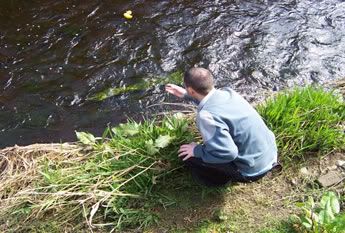
Some people resorted to any method to win. Those people know who they are - and although they may have a clear conscience, history will judge them. That's all I have to say on the matter. Oh - that, and the fact that Grant was helping someone else's duck here, so he's probably a hero.
Half of the ducks were red, and half yellow - but for some strange reason the yellow ones were much faster. Months of aerodynamic work in the wind tunnel by the red duck engineers wasted, then. I wasn't sure, but I'm betting mine was probably red.
At a guess there were about 100 people following the race, which went over a course about 200m from the Deanhaugh Bridge to the cricket ground bridge. There were a few bemused tourists caught up in the excitement too - these crazy British, eh?
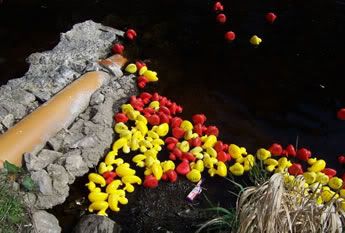
There were many fallers at 'The Pipe'.
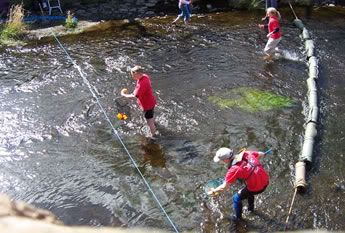
At the end of the course the stewards pulled out the lucky winners and shouted the numbers out for the judge to write down. Winners are notified by post - so none of us knows if we won anything. Imagine if all the Grand National jockeys wore the same colour and the winning trainer found out a week later...
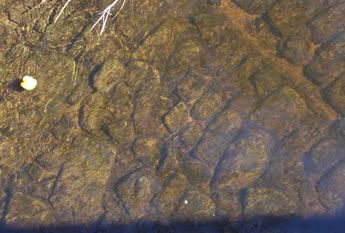
This one didn't win, caught in a slow-moving eddy. After the race the volunteers had to wade upstream picking up all the runners that never made it, caught on rocks and weeds en route. But the ducks love it, it's their one day in the spotlight.
Of course, there was no shortage of helpers to lend a hand in the cleanup. I heard one woman point to a real-life duck (I have no idea what they made of it) and tell her daughter 'Look! There's the referee!'
Tuesday, April 18, 2006
You clever people...
Some scenery, last year

'Never underestimate your audience' is an old saying, and so for what is my 200th post on DUaB I thought I'd turn the tables and write something mildly puke-inducing about you lovely readers. In times gone by, diaries were something intensely private and to be protected - but these days any fool with a computer can knock something out and force themselves on the public, pretending to be a literary wit (works for me). And if you put pretty photos up, so much the better.
It goes without saying I appreciate everyone who reads and comments on here - and is one of the reasons I keep track of you all so closely (kudos to the visitor who found me by searching for 'funeral indoor eternal flame'. Apparently the link was a post I wrote about the war memorial under the Arc de Triomphe - which is maybe slightly out of their price range). But I'm sure you weren't aware that in visiting DUaB, you are proving yourselves to be in the top echelon of society? Yes - even you with the Pringles. When the A-Team invented the internet in the early 1990's, obscurity meant relatively few people had access to or understood it. Today however almost everybody has access to the internet, and even fewer people understand it. I know I don't.
But whereas in previous times people online weren't exactly at the forefront of society (apart from in the technological sense), it has now all changed. In a classic episode of The Simpsons - the one where Bart and Lisa start a kids' revolt against their annoying parents - when Lisa suggests they air their grievances on the internet, Bart says no - "We have to reach people who's opinions actually matter". Not any more. Ironically, their choice of medium - radio - seems recently to have rejuevated, and only because of the internet (online radio, podcasting etc).
But before this post sounds any more like a Media Studies essay, I point you to an article on today's Guardian website (Link), the headline of which is 'Ignore bloggers at your peril, say researchers'. A Technology company found Bloggers are exerting a "disproportionately large influence" on society, and are "increasingly dominating public conversations and creating business trends". Like Butter pies, for instance.
The author of the report - entitled 'An Army of Davids', went on to say "Bloggers and blog-readers are 'influentials' - the minority that pays attention to events outside of political and news cycles. They also tend on average to be better off, better educated and, more importantly, employed." So put down those Jaffa Cakes and pat yourself on the back, especially if you're reading this at work.
There are now more than 35m blogs around the world. 35 million. As the BBC notes - 'while most bloggers only write for small audiences, [I prefer 'exclusive'] 'they can sometimes achieve wider fame or become the focus of consumer campaigns'. A good case in point is the story of the Million Dollar Homepage, or more recently Kyle MacDonald's trading blog. MacDonald is a 26yr-old Canadian who found a large red paper clip, and offered it online in a trade for something else - with a view to eventually trading up enough to get a house. Well within a year, he managed it.
So it seems that if you have a computer and an idea, you can combine the two and make something serious happen. Or like me, you can simply waffle on about places you've been, pies, and Irn-Bru. And post pretty pictures. But then that's why you come back, right?

'Never underestimate your audience' is an old saying, and so for what is my 200th post on DUaB I thought I'd turn the tables and write something mildly puke-inducing about you lovely readers. In times gone by, diaries were something intensely private and to be protected - but these days any fool with a computer can knock something out and force themselves on the public, pretending to be a literary wit (works for me). And if you put pretty photos up, so much the better.
It goes without saying I appreciate everyone who reads and comments on here - and is one of the reasons I keep track of you all so closely (kudos to the visitor who found me by searching for 'funeral indoor eternal flame'. Apparently the link was a post I wrote about the war memorial under the Arc de Triomphe - which is maybe slightly out of their price range). But I'm sure you weren't aware that in visiting DUaB, you are proving yourselves to be in the top echelon of society? Yes - even you with the Pringles. When the A-Team invented the internet in the early 1990's, obscurity meant relatively few people had access to or understood it. Today however almost everybody has access to the internet, and even fewer people understand it. I know I don't.
But whereas in previous times people online weren't exactly at the forefront of society (apart from in the technological sense), it has now all changed. In a classic episode of The Simpsons - the one where Bart and Lisa start a kids' revolt against their annoying parents - when Lisa suggests they air their grievances on the internet, Bart says no - "We have to reach people who's opinions actually matter". Not any more. Ironically, their choice of medium - radio - seems recently to have rejuevated, and only because of the internet (online radio, podcasting etc).
But before this post sounds any more like a Media Studies essay, I point you to an article on today's Guardian website (Link), the headline of which is 'Ignore bloggers at your peril, say researchers'. A Technology company found Bloggers are exerting a "disproportionately large influence" on society, and are "increasingly dominating public conversations and creating business trends". Like Butter pies, for instance.
The author of the report - entitled 'An Army of Davids', went on to say "Bloggers and blog-readers are 'influentials' - the minority that pays attention to events outside of political and news cycles. They also tend on average to be better off, better educated and, more importantly, employed." So put down those Jaffa Cakes and pat yourself on the back, especially if you're reading this at work.
There are now more than 35m blogs around the world. 35 million. As the BBC notes - 'while most bloggers only write for small audiences, [I prefer 'exclusive'] 'they can sometimes achieve wider fame or become the focus of consumer campaigns'. A good case in point is the story of the Million Dollar Homepage, or more recently Kyle MacDonald's trading blog. MacDonald is a 26yr-old Canadian who found a large red paper clip, and offered it online in a trade for something else - with a view to eventually trading up enough to get a house. Well within a year, he managed it.
So it seems that if you have a computer and an idea, you can combine the two and make something serious happen. Or like me, you can simply waffle on about places you've been, pies, and Irn-Bru. And post pretty pictures. But then that's why you come back, right?
Friday, April 14, 2006
Halfway Back
1yr ago today...
Exactly a year ago I wrote this post in a Korean-run Internet gaming centre in Sydney. At the time I was wondering if my time abroad would seem to have gone by quickly when I returned to the UK, and seeing as I've now been back here exactly six months I should probably try and answer. In a word, not really. I managed to cram so much into that year that time never seemed to fly by, and sitting here thinking about it now although the 14th of October 2004 seems like a long time ago, it doesn't really (if that makes any sense at all).
But to try and wrap up other points of that post, yes it was good to return to my family, friends and x-box (in no particular order), you can be the judge of whether this blog became more interesting, and if I could go away again I would absolutely jump at the chance. And I hope I answered Princess's question(s)...
My last post, about the real seven wonders of Scotland, should probably have included 'Escaped Pets' (when you make a list you always miss something obvious off). This week West Lothian has been gripped - like an unwary poodle - by Eagle Owl fever, after the escape of a pet from a shed in Linlithgow. Having seen the cramped aviary on the news, I'm rooting for Fergus the 3ft owl - described by the Police as being 'distinctive' - to stay wild, especially as it apparently eats pet dogs. Go get 'em Fergus!
edit - Eagle Owl Update...Fergus has now been missing for four days. In a statement, West Lothian Police said 'the public should not attempt to catch it themselves', but call the Police - who will presumably sramble their elite Owl Retrieval Unit. There have been a few sightings, but they turned out to be of a concrete owl on a roof. Easily done. Link
edit 2 - Eagle Owl Update...For those of you on the edges of your seats (or perches) about the fate of Scotland's most famous Eagle Owl, Fergus was recaptured on Saturday morning, after five days on the run (on the wing?). A local gamekeeper had managed to capture it, and the plucky owl is now back in his shed at the bottom of some bloke's garden. The region's pets can breathe a collective sigh of relief...

Exactly a year ago I wrote this post in a Korean-run Internet gaming centre in Sydney. At the time I was wondering if my time abroad would seem to have gone by quickly when I returned to the UK, and seeing as I've now been back here exactly six months I should probably try and answer. In a word, not really. I managed to cram so much into that year that time never seemed to fly by, and sitting here thinking about it now although the 14th of October 2004 seems like a long time ago, it doesn't really (if that makes any sense at all).
But to try and wrap up other points of that post, yes it was good to return to my family, friends and x-box (in no particular order), you can be the judge of whether this blog became more interesting, and if I could go away again I would absolutely jump at the chance. And I hope I answered Princess's question(s)...
My last post, about the real seven wonders of Scotland, should probably have included 'Escaped Pets' (when you make a list you always miss something obvious off). This week West Lothian has been gripped - like an unwary poodle - by Eagle Owl fever, after the escape of a pet from a shed in Linlithgow. Having seen the cramped aviary on the news, I'm rooting for Fergus the 3ft owl - described by the Police as being 'distinctive' - to stay wild, especially as it apparently eats pet dogs. Go get 'em Fergus!
edit - Eagle Owl Update...Fergus has now been missing for four days. In a statement, West Lothian Police said 'the public should not attempt to catch it themselves', but call the Police - who will presumably sramble their elite Owl Retrieval Unit. There have been a few sightings, but they turned out to be of a concrete owl on a roof. Easily done. Link
edit 2 - Eagle Owl Update...For those of you on the edges of your seats (or perches) about the fate of Scotland's most famous Eagle Owl, Fergus was recaptured on Saturday morning, after five days on the run (on the wing?). A local gamekeeper had managed to capture it, and the plucky owl is now back in his shed at the bottom of some bloke's garden. The region's pets can breathe a collective sigh of relief...
Tuesday, April 11, 2006
The Real Seven Wonders
Watch the hammer, skip! (and so forth)
Curling
Curling is a wierd sport that nobody seems to care much about (this from someone who used to play Ultimate Frisbee). Comedian Linda Smith (who sadly died recently) best summed it up, as 'housework on ice'. A few years ago at the Winter Olympics in Salt Lake City, the British women's team - all Scots - made it to the final and wound up winning the Gold medal, narrowly beating that notoriously icy nation, Switzerland. It was huge up here - millions of people stayed up to watch the final, me included. Ahem. The captain Rhona Martin won with the last toss, or whatever it's called, and they became national heroes. Until the recent Olympics when they were rubbish, and suddenly everyone has forgotten about curling. Scottish kids no longer stop stuffing their faces to pick up the slidey stone and brush-thing - and that can only be a sad thing.
Statues
In other countries there are plenty of fading war heroes rusting on stone plinths. Not in Scotland (well, there are a few), here we have things like the staggering Scott Monument on Princes Street, the architect of which unfortunately fell into a canal and drowned before it was finished. A similarly tragic story surrounds the famous Greyfriars Bobby statue of a small dog who pined for his master for many years after his death (the master's, that is). There are also the many statues of William Wallace at Stirling, the much-defaced one of Donald Dewar in Glasgow, and cartoon character Desperate Dan in Dundee. The most infamous, though, is a statue few Scots could name, but most recognise - that of the Duke of Wellington in central Glasgow. For years, drinkers have shimmied up to plonk a traffic cone on his head - and this has now become a major Glaswegian landmark. But is the statue more important than the tradition? Scots say yes, the police say no (or aye and naw).
Diet
I covered the unique Scottish diet in a previous post, so I won't add much here - other than the fact that it deserves to be one of the Wonders of Scotland. Scottish kids drink more soft drinks than anywhere else in Europe (soda to my American readers). In fact, here people don't call it that either, it's usually referred to as 'Juice' - as in a 'can of juice', so maybe that's why so many kids drink it - they're just confused. Now even Primary school pupils are weighed when they start, to keep an eye on any porky ones. But it's not just kids - even the dogs are dangerously overweight here.
Smoke free public places
Again, I was talking about this only the other day - you can go anywhere in Scotland and not have other people's smoke bother you. Great for non-smokers like me, less good for smokers. But who cares about them, eh? ;)
The weather
The middle of April and it was snowing the other day. Today is gloriously sunny, last weekend it was blowing a gale. Tomorrow it will be raining. On Tuesday I stood outside Haymarket waiting for a bus, watching wave after wave of city-bound commuters sweep out of the station and promptly have their umbrellas inverted by the mini-tornado that was whipping towards Princes Street. Scotland even has it's own type of weather - Haar - which true to form is a dank mist that rolls meanly off the sea to spoil sunny days. 'Four seasons in one day' is a widely-used weather cliché, but up here you can modify that to 'Four seasons at once, every day'.
Beaches
Scotland has some of the best beaches in the world, it's just unfortunate that the weather here gives you about 3 viable beach days per year. I was on the beach last weekend, in fact, at Yellowcraigs on the way to North Berwick. It was brilliantly sunny, but blowing a gale - good news for kite flyers. Less good news for me, doing what I normally do on beaches - rooting about for shells and bits of dead animals to bore people to tears with. In my defence, winkles and suchlike are interesting, you just don't know it. It's been a tremendous week for the Scottish coast - not only did it cough up a decaying H5N1-ridden swan (now thought to have been washed here from Germany), but some beaches are slightly radioactive, others dangerously so. They also attract odd people (no jokes about winkles there).
Tunnocks Caramel Wafers
Enough said...

Curling
Curling is a wierd sport that nobody seems to care much about (this from someone who used to play Ultimate Frisbee). Comedian Linda Smith (who sadly died recently) best summed it up, as 'housework on ice'. A few years ago at the Winter Olympics in Salt Lake City, the British women's team - all Scots - made it to the final and wound up winning the Gold medal, narrowly beating that notoriously icy nation, Switzerland. It was huge up here - millions of people stayed up to watch the final, me included. Ahem. The captain Rhona Martin won with the last toss, or whatever it's called, and they became national heroes. Until the recent Olympics when they were rubbish, and suddenly everyone has forgotten about curling. Scottish kids no longer stop stuffing their faces to pick up the slidey stone and brush-thing - and that can only be a sad thing.
Statues
In other countries there are plenty of fading war heroes rusting on stone plinths. Not in Scotland (well, there are a few), here we have things like the staggering Scott Monument on Princes Street, the architect of which unfortunately fell into a canal and drowned before it was finished. A similarly tragic story surrounds the famous Greyfriars Bobby statue of a small dog who pined for his master for many years after his death (the master's, that is). There are also the many statues of William Wallace at Stirling, the much-defaced one of Donald Dewar in Glasgow, and cartoon character Desperate Dan in Dundee. The most infamous, though, is a statue few Scots could name, but most recognise - that of the Duke of Wellington in central Glasgow. For years, drinkers have shimmied up to plonk a traffic cone on his head - and this has now become a major Glaswegian landmark. But is the statue more important than the tradition? Scots say yes, the police say no (or aye and naw).
Diet
I covered the unique Scottish diet in a previous post, so I won't add much here - other than the fact that it deserves to be one of the Wonders of Scotland. Scottish kids drink more soft drinks than anywhere else in Europe (soda to my American readers). In fact, here people don't call it that either, it's usually referred to as 'Juice' - as in a 'can of juice', so maybe that's why so many kids drink it - they're just confused. Now even Primary school pupils are weighed when they start, to keep an eye on any porky ones. But it's not just kids - even the dogs are dangerously overweight here.
Smoke free public places
Again, I was talking about this only the other day - you can go anywhere in Scotland and not have other people's smoke bother you. Great for non-smokers like me, less good for smokers. But who cares about them, eh? ;)
The weather
The middle of April and it was snowing the other day. Today is gloriously sunny, last weekend it was blowing a gale. Tomorrow it will be raining. On Tuesday I stood outside Haymarket waiting for a bus, watching wave after wave of city-bound commuters sweep out of the station and promptly have their umbrellas inverted by the mini-tornado that was whipping towards Princes Street. Scotland even has it's own type of weather - Haar - which true to form is a dank mist that rolls meanly off the sea to spoil sunny days. 'Four seasons in one day' is a widely-used weather cliché, but up here you can modify that to 'Four seasons at once, every day'.
Beaches
Scotland has some of the best beaches in the world, it's just unfortunate that the weather here gives you about 3 viable beach days per year. I was on the beach last weekend, in fact, at Yellowcraigs on the way to North Berwick. It was brilliantly sunny, but blowing a gale - good news for kite flyers. Less good news for me, doing what I normally do on beaches - rooting about for shells and bits of dead animals to bore people to tears with. In my defence, winkles and suchlike are interesting, you just don't know it. It's been a tremendous week for the Scottish coast - not only did it cough up a decaying H5N1-ridden swan (now thought to have been washed here from Germany), but some beaches are slightly radioactive, others dangerously so. They also attract odd people (no jokes about winkles there).
Tunnocks Caramel Wafers
Enough said...
Monday, April 10, 2006
Seven Wonders of Scotland
The winner

The National Trust for Scotland and The Scotsman newspaper have recently concluded a poll of the 'Seven Wonders of Scotland'. Members of the public could vote for a shortlist of 30 things that make Scotland great, or suggest their own. Below are the top seven, with the link to where the other 23 on the shortlist fared (the Scottish Parliament building finished last). Some of these are well-deserved (I do love the Forth Bridge), some not-so (Scotland's light and sky???). But see what you think. I'm currently putting together my own Seven Wonders of Scotland - look out for it sometime later this week...
1. The Forth Bridge
When it was built, the Forth Bridge was regarded as the eighth wonder of the world and it remains one of the most recognisable structures in Scotland. Sir John Fowler and Benjamin Baker's bridge is a testament to robust Victorian engineering and casts a magnificent silhouette across the waters of the Forth.
2. Single malt whisky
The pure water, the clear fresh air and the peat moorlands of Scotland all contribute to the flavours of single malt whisky, the water of life and one of our great offerings to the world. The combination of water, malted barley and yeast result in hundreds of distinctive flavours, from the smoky island malts to the sweet ambrosia of Speyside.
3. Edinburgh Old and New Town
With a stunning natural setting and a magnificent skyline, Edinburgh is a treasury of architectural marvels, from the cobbled labyrinth of the old walled city to the elegant Georgian splendour of the New Town. Every step is paved with history, from the towering achievements of the Enlightenment to the heinous crimes of grave robbers Burke and Hare.
4. Glencoe
Towering mountains and ever-changing weather characterise the eerie glen, redolent of the ghosts of one of the most bloody episodes in Scottish history. Standing in the depths of the valley, one cannot fail to be overpowered by the landscape and the almost tangible presence of the past.
5. The Prehistoric treasures of Orkney
Within a few windy miles on Orkney is a collection of standing stones which predate Stonehenge and the Pyramids. Maeshowe, the Ring of Brodgar, Stenness and Skara Brae, which are all World Heritage Sites, are potent symbols of the culture which predated and helped create Scotland.
6. The Kilt
Not only is the kilt a national form of dress, which keeps alive the tradition of the clan tartan and identifies Scots at formal gatherings around the world, it is also a design classic. French designer Jean Paul Gaultier is a fan, Vivienne Westwood created a punk version and Howie Nicholsby of Edinburgh has made plain kilts in leather and denim for stars including Vin Diesel and Robbie Williams.
7. The light and sky of Scotland
From the vast skies of Orkney to the cool clear light of the east coast and the blazing pink and orange of the Hebridean sunsets, Scotland's skies present an ever-changing panorama. Writers, poets and artists from the land of mist and mountains have celebrated the transforming beauty and peculiar qualities of Scotland's light.
list in full

The National Trust for Scotland and The Scotsman newspaper have recently concluded a poll of the 'Seven Wonders of Scotland'. Members of the public could vote for a shortlist of 30 things that make Scotland great, or suggest their own. Below are the top seven, with the link to where the other 23 on the shortlist fared (the Scottish Parliament building finished last). Some of these are well-deserved (I do love the Forth Bridge), some not-so (Scotland's light and sky???). But see what you think. I'm currently putting together my own Seven Wonders of Scotland - look out for it sometime later this week...
1. The Forth Bridge
When it was built, the Forth Bridge was regarded as the eighth wonder of the world and it remains one of the most recognisable structures in Scotland. Sir John Fowler and Benjamin Baker's bridge is a testament to robust Victorian engineering and casts a magnificent silhouette across the waters of the Forth.
2. Single malt whisky
The pure water, the clear fresh air and the peat moorlands of Scotland all contribute to the flavours of single malt whisky, the water of life and one of our great offerings to the world. The combination of water, malted barley and yeast result in hundreds of distinctive flavours, from the smoky island malts to the sweet ambrosia of Speyside.
3. Edinburgh Old and New Town
With a stunning natural setting and a magnificent skyline, Edinburgh is a treasury of architectural marvels, from the cobbled labyrinth of the old walled city to the elegant Georgian splendour of the New Town. Every step is paved with history, from the towering achievements of the Enlightenment to the heinous crimes of grave robbers Burke and Hare.
4. Glencoe
Towering mountains and ever-changing weather characterise the eerie glen, redolent of the ghosts of one of the most bloody episodes in Scottish history. Standing in the depths of the valley, one cannot fail to be overpowered by the landscape and the almost tangible presence of the past.
5. The Prehistoric treasures of Orkney
Within a few windy miles on Orkney is a collection of standing stones which predate Stonehenge and the Pyramids. Maeshowe, the Ring of Brodgar, Stenness and Skara Brae, which are all World Heritage Sites, are potent symbols of the culture which predated and helped create Scotland.
6. The Kilt
Not only is the kilt a national form of dress, which keeps alive the tradition of the clan tartan and identifies Scots at formal gatherings around the world, it is also a design classic. French designer Jean Paul Gaultier is a fan, Vivienne Westwood created a punk version and Howie Nicholsby of Edinburgh has made plain kilts in leather and denim for stars including Vin Diesel and Robbie Williams.
7. The light and sky of Scotland
From the vast skies of Orkney to the cool clear light of the east coast and the blazing pink and orange of the Hebridean sunsets, Scotland's skies present an ever-changing panorama. Writers, poets and artists from the land of mist and mountains have celebrated the transforming beauty and peculiar qualities of Scotland's light.
list in full
Thursday, April 06, 2006
Seeing from space
Google Earth is simply brilliant. You can search anywhere on the planet and find a satellite photograph of the area, and then zoom in so you can pick out individual parked cars and even people. Not all of the world is in the sharpest level of focus - just major population centres and landmarks, but it's still amazing. The above photo is my Grandad in his North London garden (the tiny white blob is his shirt). Even little green men can admire his flowering borders. Here are some more views of places from space, and my ground-based photo efforts underneath...
Sydney Opera House

Rottnest Island, WA
Arc de Triomphe, Paris
Whitsunday Islands, Queensland
Banks Peninsula, South Island, NZ
Bondi Beach, Sydney

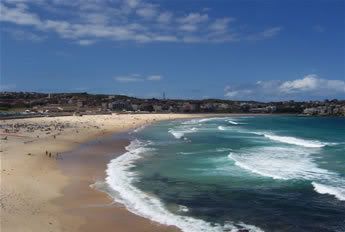
Amanohashidate, Japan
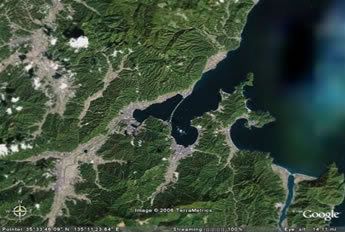
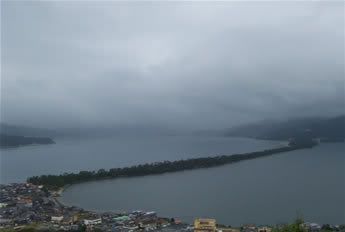
Google Earth can be downloaded free here.
Edit - Also for those of you with excess time - check out Google Sightseeing, a website (not affiliated to Google) that posts interesting and wierd things seen on Google Earth. Personal favourites include a 58ft long termite on a roof in Rhode Island, Thomas the Tank Engine at the Isle of Wight steam railway museum, and - proving that they had a lot of excess time - Googlesightseeing even managed to find a person flying a model aeroplane in a field in Essex. From space. Outstanding...
Tuesday, April 04, 2006
Bonus Louvre photos

Punters queueing to get into the Louvre on a cold and wet Parisian Sunday. The glass pyramids were constructed in 1989 from a design by a Vietnamese architect, IM Pei. Just inside is an airport-style bag scanner, and a large elevator leading down into the main entrance hall. The old building in the background is one of the three wings of the museum - the Denon - which enclose the pyramid inside an ornate and statued courtyard.

Grant and Lan struggle to take in the opulent scale of the Galerie Médicis - a single room containing over twenty mammoth canvases by Rubens. Each commissioned by Queen Marie de Médicis, they picture her being blessed by angels, moving armies of men to tears with her beauty, and receiving showers of gold from the heavens. She ruled France from 1605 to 1617, and was the mother of Louis XIII - who eventually overthrew the Italian nobles that were 'advising' her. She was twice sent into exile, and twice escaped, leading a revolt against her son before dying in Germany. I'm surprised Rubens stopped at two dozen.

An overhead view of a selection of marble statues - the Louvre has one of the largest collections of Roman and Greek statues in the world. It's a pity many people rush past them on the way to the famous individual paintings, but they are rather samey. When you've seen one stone Italian nakedly pointing at something, you've seen them all.

I had no idea the Louvre had stuff like this in it too - an incredibly detailed bone knife from one of the early Middle-Eastern civilisations. The handle is carved into a hippo tooth, which must have taken some extracting. The depictions are some kind of story, possibly involving Hippo dentistry.

Photo time in the Egyptian Gallery. There are roomfuls of mummies and sarcophaguses (sarcophagi?) in the Museum, some of which must weigh an incredible amount. The first time I ever went to Edinburgh was on a school trip to see a Pharoah exhibition, when I was about ten. You couldn't take pictures inside, so we stood in the street taking photos of the guidebook. Because of the old disc camera I had, the lens and viewfinder were inches apart, and I ended up with blurry photos of the pavement.

Japanese tourists rush past the Venus de Milo, trying to not get in the way of the picture. I've seen Michaelangelo's David in Florence, and the Venus de Milo is probably the other truly famous marble statue people eulogise over. It's impressive, too. She does have a rather blank expression on her face though, as if she's wondering where she put her arms.
Subscribe to:
Comments (Atom)